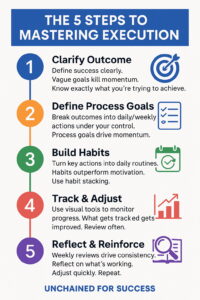Mastering Execution: Closing the Gap Between Plan and Action

1. Introduction: Why Great Plans Often Fail at Execution
Mastering execution is often where great strategies fail. I once created a solid recovery plan for a large infrastructure project—built fully on the Unchained Goals Framework. The vision was clear, the objectives were measurable, and the actions were realistic. But the plan was left to gather dust. For weeks, the client team failed to follow through. As the project slipped, pressure mounted. The client faced legal consequences for failing to meet its contractual targets. Morale dropped. Confidence evaporated.
Eventually, I was called back in—but by then, most believed it was too late to rescue the project. That’s when I proved something powerful: it wasn’t the plan that failed. It was the lack of execution.
Execution is where success lives or dies. In this blog, you’ll learn the five steps to mastering execution and turning even the most fragile plans into delivered outcomes.
2. Step 1: Clarify the Outcome – Know What You’re Really Trying to Achieve
Too many teams rush to act without defining success. Mastering execution starts with clarity. What exactly must be achieved? When? What does success look like in measurable terms?
Vague ambitions like “improve delivery” or “get back on track” are execution killers. Strong execution requires outcome clarity that anchors the entire team. This is where vision and purpose converge. If you haven’t defined your outcomes, revisit our blog Starting 2025 with Clarity for how to set a powerful vision.
The MIT Sloan Management Review also stresses the need to translate strategic clarity into operational execution, noting that without clear linkages, even great plans fail.
3. Step 2: Break Plans into Process Goals
Once the outcome is clear, the next move is to break it into process goals. These are the daily or weekly actions you can control that drive results.
In Unchained: Success Unlocked, I define these as the habits and actions you repeat consistently—the true engine of success. For example, instead of “fix reporting issues,” a process goal might be “update dashboard metrics by 9am daily.”
This step transforms theory into action. Read more on this idea in our blog Small Steps, Big Impact.
4. Step 3: Turn Process Goals into Habits
Execution fails when people rely on motivation. It succeeds when execution becomes a habit.
By building repeatable patterns into your day—like starting with a 15-minute alignment meeting or updating logs before lunch—you automate momentum. Habit-stacking and identity reinforcement are vital. As I explain in Daily Practices to Strengthen Empowering Beliefs, repeating these behaviours reprograms belief systems, creating high-performance cultures.
Harvard and Stanford research confirms that consistent repetition builds identity-based performance through a process called neuroplasticity. For further insight, see Harvard Gazette’s research on habit formation.
5. Step 4: Track Progress and Adjust Often
Execution isn’t “set and forget.”
You need regular tracking mechanisms: dashboards, scorecards, trackers. These make performance visible and ensure alignment. A system like the “Don’t Break the Chain” calendar helps keep the streak alive.
In Tools to Track and Build Better Habits, I explore both digital and manual systems that keep execution front-of-mind and course-corrected.
As Harvard Business Review puts it, “What gets measured gets improved.”
6. Step 5: Reflect Weekly and Reinforce Execution
Mastering execution requires continuous review. Without reflection, habits drift and priorities shift.
Weekly reviews ensure that actions remain aligned to the outcome goal. Ask:
- What did we commit to?
- What worked?
- What needs adapting?
This creates the Execution Loop: Plan → Act → Review → Adjust.
Our blog on Living Your New Beliefs reinforces how weekly reviews deepen integration of belief and behaviour.

7. Common Pitfalls in Execution (and How to Avoid Them)
Even with clarity, process goals, and systems, execution can derail. Common traps include:
- Perfectionism: Waiting for the perfect moment
- Overwhelm: Taking on too many goals at once
- No accountability: No one owns the follow-through
- External focus: Blaming what’s out of your control
The antidote? Simplicity. Ownership. Process goals. Daily rhythm. These tools are embedded in the Unchained framework and backed by case studies in Atomic Habits by James Clear.
8. Real-Life Story: From Failure to Delivery Under Pressure
Let me return to the story I opened with.
I had built a solid, framework-based plan for a major programme. But the delivery team failed to execute it. As the project slipped into crisis, the client faced potential prosecution. Weather disruptions and internal confusion made success seem impossible.
When I re-joined the project, I did two things:
- Updated the plan to reflect current realities
- Implemented the Unchained Goals Framework in full
We clarified the “why” — not just the business outcome but the legal and reputational risks of failure. We focused the team on what was under their control. We reframed goals into daily execution habits. We held daily reviews. We rewired language and mindset.
Despite the odds, we delivered the project on time, hit the required metrics, and eliminated the prosecution threat. All because we focused relentlessly on execution.
As McKinsey confirms: “Execution is where 70% of strategies fail.”
9. Final Call to Action: Master Execution, Master Results
It’s not your plan that determines your success. It’s what you do with it.
Mastering execution is the missing link between vision and results. If your project, business, or life feels stuck—you likely don’t need more goals. You need an execution system.
Start today:
- Clarify your outcome.
- Define your process goals.
- Build habits.
- Track progress.
- Review weekly.
Then watch how what once seemed impossible becomes inevitable.
References
- Kwegyir-Afful, C. (2023). Unchained: Success Unlocked – A Proven Framework for Achieving Your Goals.
- Harvard Business Review. (2017). Execution Is a People Problem, Not a Strategy Problem
- McKinsey & Company. (2021). Why Execution Stalls
- Clear, J. (2018). Atomic Habits: An Easy & Proven Way to Build Good Habits & Break Bad Ones.
- Psychology Today. (n.d.). “How Habits Shape Behavioural Outcomes.”
- Stanford University. (n.d.). “The Neuroscience of Habit and Behaviour.”
- Harvard Gazette. (2020). Harvard study shows how habits are formed
- MIT Sloan Management Review. (2015). Closing the Strategy Execution Gap
Want more tools like this? Explore all execution-focused blogs at https://unchainedforsuccess.com/blog




